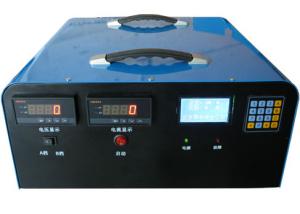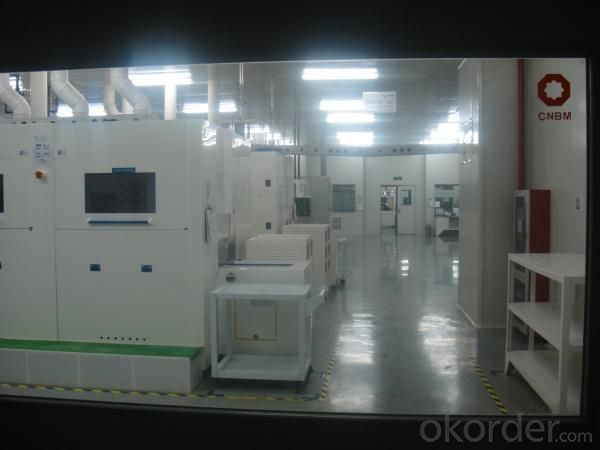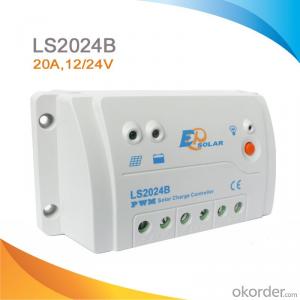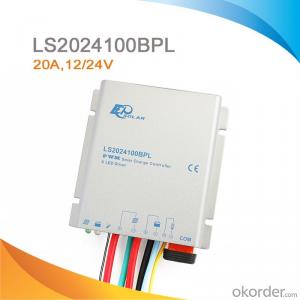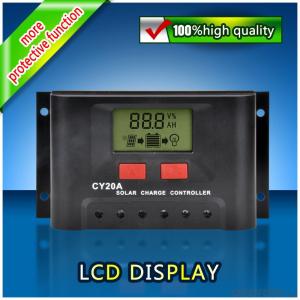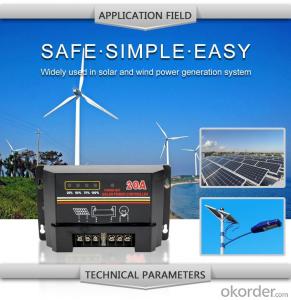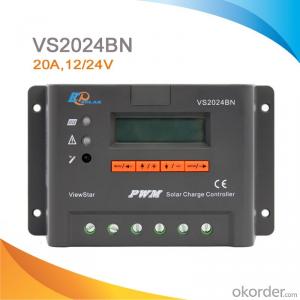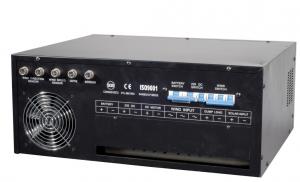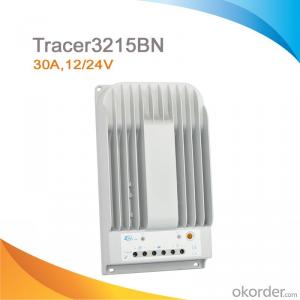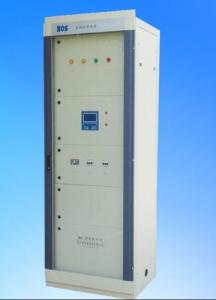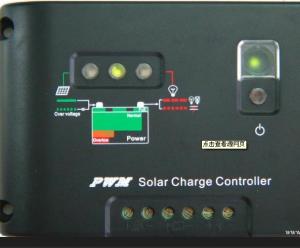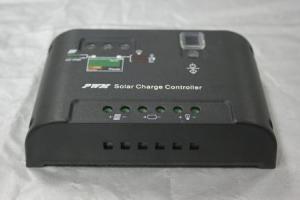20A High Quality Solar Controller with High-Precision Sampling Dot-Matrix LCD Screen
- Loading Port:
- China Main Port
- Payment Terms:
- TT
- Min Order Qty:
- 1 unit unit
- Supply Capability:
- 1000 units per month unit/month
OKorder Service Pledge
OKorder Financial Service
You Might Also Like
Introduction of High Quality Solar Controller VS1024N-3024N
VS1024N-3024N solar controller is our new generation controller for off-grid solar system, such as street light, solar home system or small power station etc.VS1024N-3024N has LCD display, reliable battery charging, full electronic protection, programmable parameters and other features and powerful function.
Our factory is highly recognized by its business partners and clients all over the world and has obtained rapid development under the spirit of win-win .With Solar Controller VS1024N-3024N,We will carry on the mutual beneficial,innovative and revolutionary trading structure as we did before,create value for our employees,share holders and clients and benefit the whole society in our future development.Please contact us ,if you have interest in Solar Controller VS1024N-3024N,don’t hesitate!
Features of High Quality Solar Controller VS1024N-3024N
·Adopt graphics dot-matrix LCD screen and HMI (human-machine interface) with 4 buttons, integrated menu displaying and operation
·32 bit MCU with high speed
·12 bit A/D high-precision sampling to ensure accuracy
·Excellent EMC design
·High efficient Series PWM charging
·Use MOSFET as electronic switch
·Widely used, automatically recognize day/night
·Humanized design of browser interface, undertake every operating conveniently
·Full control parameters setting and modification, diversified load control mode
·Gel, Sealed and Flooded battery type option
Electronic Protections of High Quality Solar Controller VS1024N-3024N
·Overheating
·Over discharging
·Over charging
·Load overload
·Load short circuit
·PV reverse polarity
·Battery reverse polarity
Data Sheet of High Quality Solar Controller VS1024N-3024N | |||
Model | VS1024N | VS2024N | VS3024N |
Rated system voltage | 12/24V auto work | ||
Rated battery current | 10A | 20A | 30A |
Rated load current | 20A | ||
Max.battery voltage | 32V | ||
Self-consumption | <18mA | ||
Charge Circuit Voltage | <=0.26V | ||
Discharge Circuit Voltage Drop | <=0.15V | ||
Communication | TTL232/8 pin RJ45 | ||
Equalize Charging Voltage | Sealed:14.6V;x2/24V Flooded | ||
Temp/compensation | -30mV/℃/12V(25℃) | ||
Working temperature | -35℃~+55℃ | ||
Storage temperature range | -35℃~+80℃ | ||
Humidity | 10%-90% NC | ||
Enclosure | IP 20 | ||
Altitude | <=3000m | ||
Mounting hole size | Φ5 | ||
Weight | 2.05kg | ||
Factory Picture of High Quality Solar Controller VS1024N-3024N
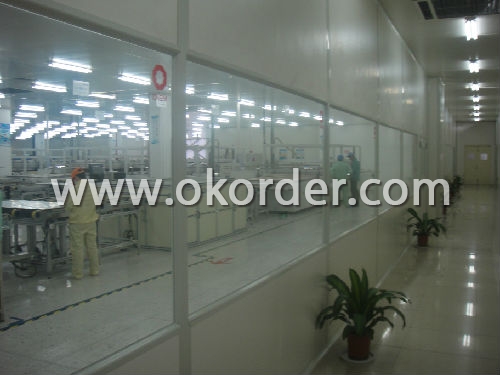
Package Picture of High Quality Solar Controller VS1024N-3024N
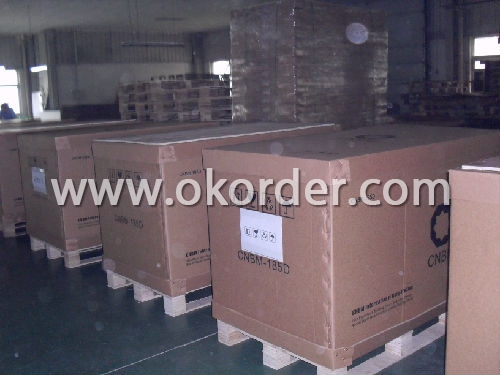
- Q: How do I ensure proper grounding for a solar controller?
- For the safety and optimal performance of your solar system, it is crucial to establish a proper grounding for the solar controller. To achieve this, please adhere to the following guidelines: 1. Select an appropriate location: When installing the solar controller, carefully choose a location that is in close proximity to both the solar panels and the battery bank. 2. Utilize a grounding rod: Place a grounding rod in the ground near the solar controller. This rod should be constructed of either copper or galvanized steel and should measure at least 8 feet in length. Drive the rod into the ground until only a few inches remain visible. 3. Establish the grounding wire connection: Connect a grounding wire to the grounding rod using a grounding clamp. Ensure that the wire is made of copper and has a minimum gauge of 8 AWG (American Wire Gauge). Verify that the connection is secure and tight. 4. Connect to the solar controller: Attach the other end of the grounding wire to the grounding terminal on the solar controller. This terminal is typically labeled as "GND" or "Ground." 5. Ensure proper bonding: Connect all metal components of the solar system, such as the solar panels, battery bank, and any metal enclosures, to the grounding terminal on the solar controller. This can be achieved by using appropriately sized grounding wires and clamps. It is essential to guarantee that all connections are secure and tight. 6. Conduct a grounding test: Upon completing the grounding connections, it is vital to test the grounding system using either a multimeter or a ground resistance tester. This will help ensure that the resistance between the grounding rod and the system components falls within acceptable limits. 7. Regularly inspect and maintain: Regularly inspect the grounding system to identify any loose or damaged connections. Additionally, keep the grounding rod and wire clean and free from corrosion or damage. By carefully following these steps, you can establish proper grounding for your solar controller, thus enhancing the safety and performance of your solar system. If you have any doubts or concerns regarding any aspect of the grounding process, it is advised to consult a professional electrician or solar installer for expert assistance.
- Q: How does a solar controller handle variations in solar panel soiling?
- A solar controller does not directly handle variations in solar panel soiling. Its main function is to regulate and optimize the flow of energy between the solar panels and the battery storage system. However, solar controllers indirectly help with mitigating the impact of panel soiling by ensuring that the solar panels are operating at their maximum efficiency. By monitoring the voltage and current output of the panels, the controller can detect any decrease in performance due to soiling and adjust the charging parameters accordingly to maintain optimal charging levels.
- Q: How does a solar controller handle shading or partial shading of solar panels?
- A solar controller handles shading or partial shading of solar panels by utilizing a technique called Maximum Power Point Tracking (MPPT). MPPT technology allows the controller to constantly monitor the voltage and current output of the solar panels and adjust the operating parameters to ensure they are always operating at their maximum power output, even when shaded. This helps to optimize the overall performance of the solar system and mitigate the impact of shading on energy generation.
- Q: Can a solar controller be used with a solar generator?
- Yes, a solar controller can be used with a solar generator. A solar controller, also known as a charge controller, regulates the flow of electricity between the solar panels and the battery in a solar generator. It prevents overcharging and extends the battery's lifespan. Therefore, using a solar controller with a solar generator is essential to ensure efficient and safe operation.
- Q: How does a solar controller work?
- A solar controller, also known as a charge controller, regulates the flow of electricity between the solar panel and the battery. It ensures that the battery is charged efficiently and protects it from damage due to overcharging or overdischarging. The solar controller monitors the battery's voltage and adjusts the charging current accordingly. It also prevents reverse current flow from the battery to the solar panel during low or no sunlight conditions. Overall, a solar controller helps optimize the performance and lifespan of the battery in a solar power system.
- Q: How to choose a solar controller
- With full short-circuit, overload, unique anti-reverse protection, full, over-automatic shutdown, recovery and other full-function protection measures, detailed charge instructions, battery status, load and a variety of fault instructions. The controller through the computer chip on the battery terminal voltage, discharge current, ambient temperature and other parameters related to the battery capacity of the sample, through the special control model calculation, to achieve the characteristics of the battery discharge rate, temperature compensation correction of high efficiency, high accuracy rate control , And adopted a high efficiency PWM battery charging mode, to ensure that the battery work in the best condition, greatly extending the battery life. With a variety of work patterns, output mode selection, to meet the various needs of users.
- Q: Are there any disadvantages to using a solar controller?
- Yes, there are a few disadvantages to using a solar controller. One disadvantage is the initial cost of purchasing and installing a solar controller, which can be relatively high compared to traditional charge controllers. Additionally, solar controllers may require regular maintenance and monitoring to ensure optimal performance, which can add to the overall maintenance cost. Another potential disadvantage is the limited compatibility of solar controllers with certain solar panel systems, as some controllers may not be compatible with certain types or sizes of solar panels. Lastly, solar controllers may have limitations in terms of the maximum amount of solar power they can handle, which can restrict the scalability of the solar system.
- Q: Can a solar controller be used with both off-grid and grid-tied systems?
- No, a solar controller cannot be used with both off-grid and grid-tied systems. Off-grid systems require a solar controller to regulate the charging and discharging of batteries, while grid-tied systems do not use batteries and rely on an inverter to convert the DC power from solar panels into AC power for immediate use or feeding back into the grid. Therefore, the controller requirements are different for each system.
- Q: How does a solar controller prevent battery discharge during nighttime or low sunlight conditions?
- A solar controller prevents battery discharge during nighttime or low sunlight conditions by effectively blocking the flow of electricity from the battery to the solar panels. It senses the voltage of the battery and automatically interrupts the connection when it reaches a certain level, ensuring that the battery remains charged and preventing any energy loss.
- Q: Can a solar controller be used with flooded batteries?
- Yes, a solar controller can be used with flooded batteries. In fact, it is recommended to use a solar controller with flooded batteries to ensure proper charging and prevent overcharging, which can damage the batteries. The solar controller regulates the charging current and voltage from the solar panels, protecting the flooded batteries and extending their lifespan.
1. Manufacturer Overview
| Location | Shenzhen,China |
| Year Established | 2009 |
| Annual Output Value | Above US$12 Million |
| Main Markets | Europe;North America;Afirca |
| Company Certifications | ISO 9001:2008;CQC;CE |
2. Manufacturer Certificates
| a) Certification Name | |
| Range | |
| Reference | |
| Validity Period |
3. Manufacturer Capability
| a) Trade Capacity | |
| Nearest Port | Shenzhen,China |
| Export Percentage | 0.6 |
| No.of Employees in Trade Department | 46 People |
| Language Spoken: | English;Chinese;Spanish |
| b) Factory Information | |
| Factory Size: | Above 300,00 square meters |
| No. of Production Lines | Above 4 |
| Contract Manufacturing | OEM Service Offered;Design Service Offered |
| Product Price Range | Average |
Send your message to us
20A High Quality Solar Controller with High-Precision Sampling Dot-Matrix LCD Screen
- Loading Port:
- China Main Port
- Payment Terms:
- TT
- Min Order Qty:
- 1 unit unit
- Supply Capability:
- 1000 units per month unit/month
OKorder Service Pledge
OKorder Financial Service
Similar products
Hot products
Hot Searches
Related keywords
